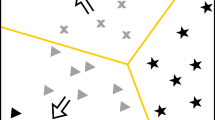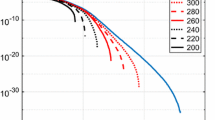Abstract
Standard least-squares collocation (LSC) assumes 2D stationarity and 3D isotropy, and relies on a covariance function to account for spatial dependence in the observed data. However, the assumption that the spatial dependence is constant throughout the region of interest may sometimes be violated. Assuming a stationary covariance structure can result in over-smoothing of, e.g., the gravity field in mountains and under-smoothing in great plains. We introduce the kernel convolution method from spatial statistics for non-stationary covariance structures, and demonstrate its advantage for dealing with non-stationarity in geodetic data. We then compared stationary and non- stationary covariance functions in 2D LSC to the empirical example of gravity anomaly interpolation near the Darling Fault, Western Australia, where the field is anisotropic and non-stationary. The results with non-stationary covariance functions are better than standard LSC in terms of formal errors and cross-validation against data not used in the interpolation, demonstrating that the use of non-stationary covariance functions can improve upon standard (stationary) LSC.
Similar content being viewed by others
References
Armstrong M (1998) Basic linear geostatistics. Springer, Berlin
Atkinson PM, Lloyd CD (2007) Non-stationary variogram models for geostatistical sampling optimisation: an empirical investigation using elevation data, Comput & Geosci 33: 1285–1300. doi:10.1016/j.cageo.2007.05.011
Chilès JP, Delfiner P (1999) Geostatistics. Wiley, New York
Cressie N (1993) Statistics for spatial data. Wiley, New York
Dermanis A (1984) Kriging and collocation—a comparison. Manuscr Geod 9: 159–167
Deutsch CV, Journel AG (1998) GSLIB. Oxford University Press, Oxford
Duquenne H, Everaerts M, Lambot P (2005) Merging a gravimetric model of the geoid with GPS/levelling data: an example in Belgium. In: Jekeli C, Bastos L, Fernandes J (eds) Gravity, geoid and space missions. Springer, Berlin, pp 131–136
Featherstone WE, Sproule DM (2006) Fitting AusGeoid98 to the Australian Height Datum using GPS-levelling and least squares collocation: application of a cross-validation technique. Surv Rev 38(301): 573–582
Fieguth PW, Karl WC, Willsky AS, Wunsch C (1995) Multiresolution optimal interpolation and statistical analysis of TOPEX/Poseidon satellite altimetry. IEEE Trans Geosci Remote Sens 33(2): 280–292. doi:10.1109/36.377928
Flury J (2006) Short-wavelength spectral properties of the gravity field from a range of regional data sets. J Geod 79(10-11): 624–640. doi:10.1007/s00190-005-0011-y
Forsberg R (1986) Spectral properties of the gravity field in the nordic countries. Boll Geodesia e Sc Aff XLV: 361–384
Fuentes M (2001) A high frequency Kriging approach for non-stationary environmental processes. Environmetrics 12(5): 469–483. doi:10.1002/env.473
Fuentes M, Smith R (2003) A new class of non-stationary spatial models. Technical report, Department of Statistics, North Carolina State University
Gaposchkin EM (1973) Standard Earth III-1973. Special report 353, Smithsonian Astrophysical Observatory Cambridge
Goad CC, Tscherning CC, Chin MM (1984) Gravity empirical covariance values for the continental United States. J Geophys Res 89(B9): 7962–7968
Goos JM, Featherstone WE, Kirby JF, Holmes SA (2003) Experiments with two different approaches to gridding terrestrial gravity anomalies and their effect on regional geoid computation. Surv Rev 37(288): 92–112
Goovaerts P (1997) Geostatistics for natural resources evaluation. Oxford University Press, Oxford
Higdon D, Swall J, Kern J (1999) Non-stationary spatial modelling. In: Bernardo JM, Berger JO, Dawid AP, Smith AFM (eds) Bayesian statistics 6. Oxford University Press, Oxford, pp 761–768
Kearsley W (1977) Non-stationary estimation in gravity prediction problem. Report 256, Department of Geodetic Science, The Ohio State University, Columbus
Keller W (1998) Collocation in reproducing kernel Hilbert spaces of a multiscale analysis. Phys Chem Earth 23(1): 25–29
Keller W (2000) A wavelet approach to non-stationary collocation. In: Schwarz KP (eds) Geodesy beyond 2000. Springer, Berlin, pp 208–214
Keller W (2002) A wavelet solution to 1D non-stationary collocation with extension to the 2D case. In: Sideris MG (eds) Gravity, geoid and geodynamics 2000. Springer, Berlin, pp 79–84
Kirby JF, Featherstone WE (2002) High-resolution grids of gravimetric terrain correction and complete Bouguer corrections over Australia. Explor Geophys 33: 161–165
Kirby JF (2003) On the combination of gravity anomalies and gravity disturbances for geoid determination in Western Australia. J Geod 77(7-8): 433–439. doi:10.1007/s00190-003-0334-5
Knudsen P (2005) Patching local empirical covariance functions—a problem in altimeter data processing. In: Sansò F (eds) A window on the future of geodesy. Springer, Berlin, pp 483–487
Kotsakis C, Sideris MG (1999) The long road from deterministic collocation to multiresolution approximation. Report 1999.5. Department of Geodesy and Geoinformatics, Stuttgart University
Kotsakis C (2000) The multiresolution character of collocation. J Geod 74(3–4): 275–290. doi:10.1007/s001900050286
Krarup T (1969) A contribution to the mathematical foundation of physical geodesy, Rep 44. Danish Geodetic Institute, Copenhagen
Krige DG (1951) A statistical approach to some basic mine valuation problems on the Witwatersrand. J Chem Metall Min Soc S Afr 52: 119–139
Lambeck K (1987) The Perth Basin: a possible framework for its formation and evolution. Explor Geophys 18(2): 124–128. doi:10.1071/EG987124
Lemoine FG, Kenyon SC, Factor JK, Trimmer RG, Pavlis NK, Chinn DS, Cox CM, Klosko SM, Luthcke SB, Torrence MH, Wang YM, Williamson RG, Pavlis EC, Rapp RH , Olson TR (1998) The development of the joint NASA GSFC and the National Imagery and Mapping Agency (NIMA) geopotential model EGM96. Technical report NASA/TP-1998- 206861, National Aeronautics and Space Administration, Greenbelt, pp 575
Mahalanobis PC (1936) On the generalized distance in statistics. Proc Natl Inst Sci India 12: 49–55
Matheron G (1962) Traité de Géostatistique Appliquée, Tome I, Mémoires du Bureau de Recherches Géologiques et Minières, No. 14. Editions Technip, Paris
Moreaux G, Tscherning CC, Sansò F (1999) Approximation of harmonic covariance functions on the sphere by non harmonic locally supported functions. J Geod 73: 555–567
Moritz H (1980) Advanced physical geodesy. Abacus, Tunbridge Wells
Nychka DW, Wikle C, Royle JA (2002) Multiresolution models for non-stationary spatial covariance functions. Stat Modell 2(4): 315–331. doi:10.1191/1471082x02st037oa
Paciorek CJ (2003) Non-stationary Gaussian processes for regression and spatial modelling. Ph.D. thesis, Carnegie Mellon University, Pittsburgh
Paciorek CJ, Schervish MJ (2006) Spatial modelling using a new class of non-stationary covariance functions. Environmetrics 17(5): 483–506. doi:10.1002/env.785
Rapp RH (1964) The prediction of point and mean gravity anomalies through the use of the digital computer. Report 43, Department of Geodetic Sciences, The Ohio State University, Columbus
Reguzzoni M, Sansò F, Venuti G (2005) The theory of general Kriging, with application to the determination of a local geoid. Geophys J Int 162(4): 303–314. doi:10.1111/j.1365-246X.2005.02662.x
Robert CP, Casella G (2004) Monte carlo statistical methods, 2nd edn. Springer, Berlin
Sampson PD, Guttorp P (1992) Nonparametric estimation of non-stationary spatial covariance structure. J Am. Stat Assoc 87(417): 108–119. doi:10.2307/2290458
Sampson P, Damian D, Guttorp P (2001) Advances in modeling and inference for environmental processes with non-stationary spatial covariance. In: Monestiez P, Allard D, Froidvaux R (eds) GeoENV 2000: Geostatistics for environmental applications. Kluwer, Dordrecht, pp 17–32
Sansò F, Venuti G, Tscherning CC (2000) A theorem of insensivity of the collocation solution to variations of the metric in the interpolation space. In: Schwarz KP (eds) International association of geodesy symposia, vol 121. Springer, Heidelberg, pp 233–240
Schaffrin B, Felus Y (2005) On total least-squares adjustment with constraints. In: Sansò F (eds) International association of geodesy symposia, vol 128. Springer, Heidelberg, pp 417–421
Schwarz KP, Lachapelle G (1980) Local characteristics of the gravity anomaly covariance function. Bull Géod 54(1): 21–36
Swall JL (1999) Non-stationary spatial modelling using a process convolution approach. Ph.D. thesis, Institute of Statistics and Decision Sciences, Duke University, Durham
Tscherning CC, Rapp RH (1974) Closed covariance expressions for gravity anomalies, geoid undulations, and deflections of the vertical implied by anomaly degree variance models. Report 208, Department of Geodetic Sciences, The Ohio State University, Columbus
Tscherning CC (1975) Application of collocation for the planning of gravity surveys. J Geod 49(2): 183–198
Tscherning CC, Sansò F, Arabelos D (1987) Merging regional geoids—preliminary considerations and experiences. Boll di Geodesia e Sci Aff XLVI(3): 191–206
Tscherning CC (1991) Density-gravity covariance functions produced by overlapping rectangular blocks of constant density. Geophys J Int 105(3): 771–776. doi:10.1111/j.1365-246X.1991.tb00811.x
Tscherning CC (1994) Geoid determination by least-squares collocation using GRAVSOFT. Lectures notes for the international school for the determination and use of the Geoid. DIIAR, Politecnico di Milano, Milano
Tscherning CC (1999) Construction of anisotropic covariance functions using Riesz-representers. J Geod 73(6): 332–336. doi:10.1007/s001900050250
Vyskǒcil V (1970) On the covariance and structure functions of anomalous gravity field. Stud Geophys et Geod 14(2): 174–177. doi:10.1007/BF02585616
Xu PL (1991) Least squares collocation with incorrect prior information. Z Verm 116: 266–273
Author information
Authors and Affiliations
Corresponding author
Rights and permissions
About this article
Cite this article
Darbeheshti, N., Featherstone, W.E. Non-stationary covariance function modelling in 2D least-squares collocation. J Geod 83, 495–508 (2009). https://doi.org/10.1007/s00190-008-0267-0
Received:
Accepted:
Published:
Issue Date:
DOI: https://doi.org/10.1007/s00190-008-0267-0




